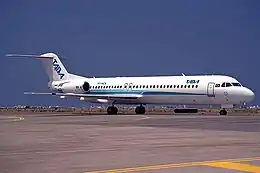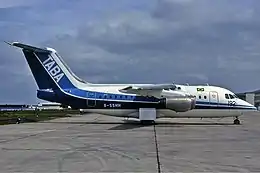| |||||||
| Founded | 1976 | ||||||
|---|---|---|---|---|---|---|---|
| Ceased operations | 1999 | ||||||
| Headquarters | Belém, Brazil | ||||||
| Key people | Marcílio Jacques Gibson | ||||||


TABA – Transportes Aéreos Regionais da Bacia Amazônica was a Brazilian airline founded in 1976. It ceased operations in 1999.
History
On November 11, 1975 the Brazilian Federal Government created the Brazilian Integrated System of Regional Air Transportation and divided the country in five different regions, for which five newly created regional airlines received a concession to operate air services. TABA – Transportes Aéreos Regionais da Bacia Amazônica S/A was the first of those regional airlines to be made operational. Its services started on April 29, 1976 and its operational area comprised roughly the North and parts of the Central-West regions of Brazil, specifically the states of Acre, Amazonas, Amapá, Rondônia, Roraima, and parts of Pará and Mato Grosso.[1]
The history of TABA can be traced to the 1960s, when Marcílio Jacques Gibson who, decades earlier had been one of the share-holders of Lóide Aéreo Nacional before it was sold to VASP, bought Nota – Norte Táxi Aéreo based in Belém. This air taxi operator belonged to the son of the owner of Paraense Transportes Aéreos. When, in 1970, Paraense ceased operations, Gibson used his air taxi operator to fill the void left by Paraense, particularly in the states of Pará and Amapá, offering flights to locations that ceased to be served by air services. During this time, flights were operated by Beechcraft D-18S/H-18S aircraft configured for 9 passengers. After the closure of Paraense, Nota added to its fleet the Curtiss C-46 Commando and Fairchild Hiller FH-227B that previously belonged to Paraense. It was on the foundations of Nota that TABA was created. The former fleet of Nota was further enlarged by the addition of a few Embraer EMB 110 Bandeirante.[2]
In November 1980 TABA had services to 34 cities with a fleet of 10 Embraer EMB 110 Bandeirante and 4 Fairchild Hiller FH-227B. Between 1983 and 1985 TABA operated 2 British Aerospace BAe 146 on the trunk-route Belém-Val de Cães/Itaituba/Alta Floresta/Cuiabá/Vilhena/Ji-Paraná/Porto Velho. However high operating and maintenance costs led TABA to end the leasing contract.
When in 1991 the Federal Government lifted the geographic restrictions for the operations of regional airlines, TABA inaugurated services to Rio de Janeiro-Santos Dumont and Belo Horizonte-Pampulha, linking those two cities to its already established network in the Amazon Basin. During this time TABA also initiated the renovation of its fleet replacing the Fairchild Hiller FH-227B for Bombardier Dash 8-300.[3] In 1992 TABA started services to Georgetown, Guyana, being the first regional airline to establish international flights.
TABA operated 2 Fokker 100 between 1993 and 1995 but increasing economic difficulties led to the end of their lease contract. In an attempt to replace services operated by those aircraft, TABA chartered a Boeing 727-200 belonging to the Brazilian charter operator Air Vias on weekdays. Their contract ended in November 1995 when Air Vias ceased to fly. Operations with the Dash 8-300 were also canceled in 1996 and aircraft were returned to the lessor.
In 1997 TABA was already in serious economic trouble and finally in 1999 it ceased operations.
Destinations
TABA operated an extensive network in the Northern and Central-West regions of Brazil.
Fleet
| Aircraft | Total | Years of operation | Notes |
|---|---|---|---|
| Beechcraft D-18S/H-18S | 7 | 1976–1979 | |
| Curtiss C-46 Commando | 1 | 1976–1981 | |
| Embraer EMB 110 Bandeirante | 11 | 1976–1999 | |
| Fairchild Hiller FH-227B | 8 | 1976–1999 | |
| British Aerospace 146 | 2 | 1983–1985 | |
| Bombardier Dash 8-300 | 6 | 1991–1996 | |
| Fokker 100 | 2 | 1993–1995 | |
| Boeing 727-200 | 1 | 1995–1995 | chartered from Air Vias |
Accidents and incidents
Accidents
- 31 January 1978: an Embraer EMB 110 Bandeirante registration PT-GKW crashed upon take-off from Eirunepé. The crew of 2 died but all 14 passengers survived.[5]
- 12 June 1982: a Fairchild Hiller FH-227 registration PT-LBV en route from Eirunepé to Tabatinga on approach to Tabatinga collided with a pole in poor visibility and crashed onto a car park. All 40 passengers and 4 crew died.[6][7]
- 23 June 1985: an Embraer EMB 110 Bandeirante registration PT-GJN flying from Juara to Cuiabá while on approach to land at Cuiabá had technical problems on engine number 1. An emergency landing was attempted but the aircraft stalled and crashed 1 km short of the runway. All 17 occupants died.[8][9]
- 6 June 1990: a Fairchild Hiller FH-227 registration PT-ICA flying from Belém-Val de Cans to Cuiabá via Altamira, Santarém, Itaituba and Alta Floresta, while on approach to land under fog at Altamira, descended below the approach path, collided with trees and crashed 850m short of the runway. Of the 41 passengers and crew, 23 died.[10][11]
- 25 January 1993: a Fairchild Hiller FH-227 registration PT-LCS operating a cargo flight from Belém-Val de Cans to Altamira crashed into the jungle near Altamira during night-time approach procedures. The crew of 3 died.[12]
- 28 November 1995: a Fairchild Hiller FH-227 registration PP-BUJ operating a cargo flight from Belém-Val de Cans to Santarém crashed on its second attempt to approach Santarém. The crew of 2 and 1 of the 2 occupants died.[13]
Incidents
- 6 March 1991: an Embraer EMB 110 Bandeirante flying to Manaus was hijacked near São Gabriel da Cachoeira by 3 persons.[14]
- 15 December 1994: an Embraer EMB 110 Bandeirante en route from Carauari and Tefé to Manaus was hijacked by two Colombian citizens. The passengers were released in the proximity of Tabatinga and the aircraft was flown to Colombia. The crew was released at the Brazilian Embassy in Bogotá.[15]
See also
References
- ↑ Garófalo, Gílson de Lima (1982). O Mercado Brasileiro de Transporte Aéreo Regional (in Portuguese). São Paulo: Instituto de Pesquisas Econômicas. pp. 103–107, 119–121.
- ↑ Pereira, Aldo (1987). Breve História da Aviação Comercial Brasileira (in Portuguese). Rio de Janeiro: Europa. pp. 254–256.
- ↑ "TABA – Transportes Aéreos da Bacia Amazônica (Brasil)" (in Portuguese). Aviação Brasil. Archived from the original on 3 October 2011. Retrieved 12 June 2010.
- ↑ Pereira, Aldo (1987). Breve História da Aviação Comercial Brasileira (in Portuguese). Rio de Janeiro: Europa. pp. 255–256.
- ↑ "Accident description PT-GKW". Aviation Safety Network. Retrieved 30 May 2011.
- ↑ "Accident description PT-LBV". Aviation Safety Network. Retrieved 30 May 2011.
- ↑ Germano da Silva, Carlos Ari César (2008). "Aru traiçoeiro". O rastro da bruxa: história da aviação comercial brasileira no século XX através dos seus acidentes 1928-1996 (in Portuguese) (2 ed.). Porto Alegre: EDIPUCRS. pp. 327–331. ISBN 978-85-7430-760-2.
- ↑ "Accident description PT-GJN". Aviation Safety Network. Retrieved 6 August 2011.
- ↑ Germano da Silva, Carlos Ari César (2008). "Obstáculo imprevisto". O rastro da bruxa: história da aviação comercial brasileira no século XX através dos seus acidentes 1928-1996 (in Portuguese) (2 ed.). Porto Alegre: EDIPUCRS. pp. 342–344. ISBN 978-85-7430-760-2.
- ↑ "Accident description PT-ICA". Aviation Safety Network. Retrieved 8 May 2011.
- ↑ Germano da Silva, Carlos Ari César (2008). "Nevoeiro na reta final". O rastro da bruxa: história da aviação comercial brasileira no século XX através dos seus acidentes 1928-1996 (in Portuguese) (2 ed.). Porto Alegre: EDIPUCRS. pp. 361–363. ISBN 978-85-7430-760-2.
- ↑ "Accident description PT-LCS". Aviation Safety Network. Retrieved 8 May 2011.
- ↑ "Accident description PP-BUJ". Aviation Safety Network. Retrieved 14 May 2011.
- ↑ "Incident description 6 March 1991". Aviation Safety Network. Retrieved 15 July 2011.
- ↑ "Incident description 15 December 1994". Aviation Safety Network. Retrieved 15 July 2011.